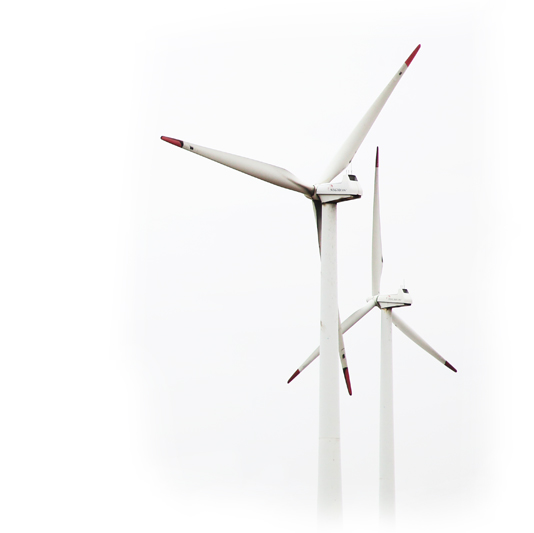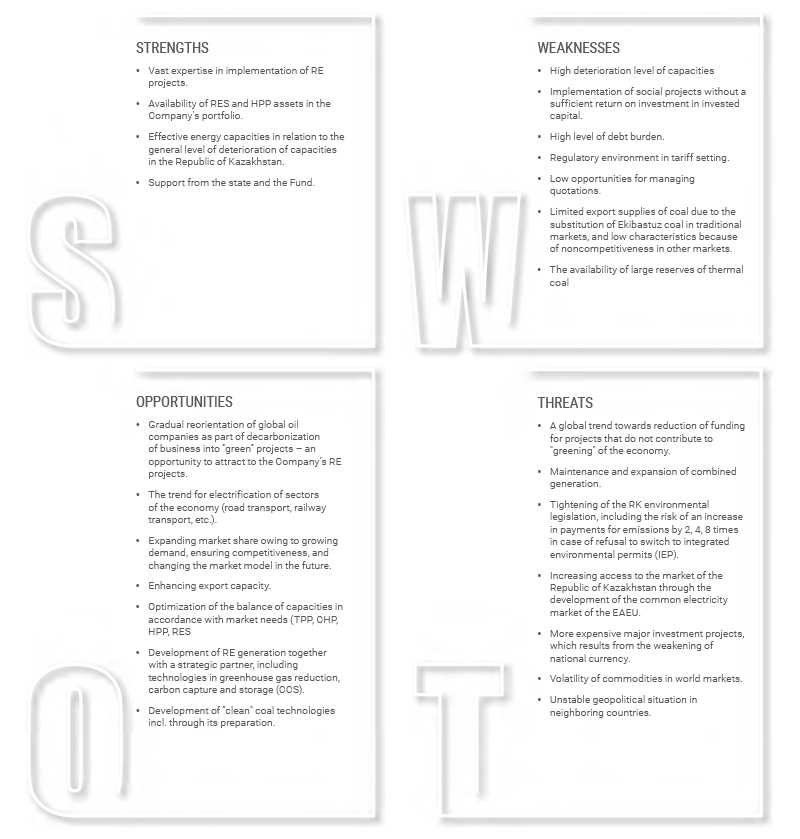VISION
An efficient high-tech operating energy company with high social and environmental responsibility – the leader in Kazakhstan’s energy sector.
MISSION
Create value for shareholders, meet growing demand through reliable energy supplies, hightech development, environmental friendliness, guided by the principles of sustainable development.
STRATEGIC DIRECTIONS
Transition to a “green economy”
Ensuring reliable competitive supplies of energy resources in target markets
Maximizing shareholder value

COMPANY’S DEVELOPMENT STRATEGY
The world is embarking on the stage of 4th energy transition to the widespread use of renewable energy sources, which over time will largely supersede fossil fuels – gas, oil, coal.
Recognizing the importance of the agenda and risks associated with operations based on coal generation, the Company will be committed to minimize adverse environmental impact and achieve carbon neutrality until 2060.
In this connection, the Company updated its Development Strategy in 2021, approving it for 2022–2031. Various activities are planned to be implemented, which include: the construction of renewable energy generation facilities, the transfer of some assets to gas, the use of best available technologies in carbon capture and storage, accumulation, planting trees, digitization, and energy efficiency.
The major factors contributing to the need for updating the Strategy are:
- The need to develop and implement the energy transition program and its integration into the Development Strategy.
- The need to apply the best available technologies (BAT) to reduce emissions.
- The need to apply ESG principles.
- The trend towards digitization of production and operating processes.
- Changes in the list and key characteristics of investment projects.
- Changes in the regulatory environment in power industry.
“Samruk-Energy” JSC Strategy for 2022–2031 adheres to the principles of sustainable development set out in the United Nations Global Compact, such as:
- Commitment to the principles of sustainable development at the level of the Board of Directors, executive body and employees.
- Analysis of the internal and external situation in three components (economics, ecology, social issues).
- Identification of risks in sustainable development in the social, economic, and environmental areas.
- Creation of stakeholders’ map.
- Setting goals and KPI in sustainable development, development of an action plan and identification of responsible persons.
- Integration of sustainable development into key processes, including risk management, planning, human resource management, investments, reporting, operations, and others, as well as into the Development Strategy and decision-making processes.
- Professional development of senior executives and employees in sustainable development.
- Regular monitoring and evaluation of activities in sustainable development, assessment of performance and goals achievement, taking corrective actions, implementing a culture of continuous improvement.
The updated Development Strategy also considers the state policy in strategic planning of the national energy security system, the development of power industry, and is in line with the key strategic directions, goals and objectives of the Sole Shareholder.
The Company's strategic goals and objectives are determined using the PESTEL analysis, analysis of macroeconomic and industry trends and internal environment.
KEY EXTERNAL CHALLENGE
- Tightening of environmental legislation requirements.
The new RK Environmental Code (hereinafter – the Code) imposes requirements for 1st category enterprises for the transition to integrated environmental permits and introduction of the best available techniques. In case of non-compliance with the Code’s requirements, there will be a phased increase in tax rates for environmental emissions.
- Establishment of electricity balancing market.
The introduction of online balancing electricity market involves the creation of economic signals for entities of the wholesale electricity market to comply with their own daily schedule for production / consumption of electricity and participate in the elimination of power imbalances in the power system.
- Regulatory measures on development of centralized
electricity trading.
As part of legislative changes on development of competition, the Agency for the Protection and Development of Competition proposes to amend the Law of the Republic of Kazakhstan "On Power Industry" as regards establishing the share of electricity subject to mandatory sale through centralized bidding.
- Establishment of Common Electricity Market
of Eurasian Economic Union.
The full-scale operation of the common market is expected from January 1, 2025 after establishment of the common gas market. As a result of establishment of the common electricity market of the EAEU, the Republic of Kazakhstan will receive not only simplified access to the markets of the Union member states, but also increase the openness of the internal market for external suppliers of electricity.
- Implementation of national and infrastructure projects.
“Samruk-Energy” JSC subsidiaries are working on the following projects: “Modernization of Almaty CHP-2 including reduction of environmental impact”, “Reconstruction of Almaty CHP-3 on the basis of a CCGT unit with an increase in the capacity of the station to 450 MW”, "Expansion of CHP-1 with construction of a 200- 250 MW CCGT unit" and “Reconstruction of cable grids in Almaty city and Almaty region”
- Implementation of Transformation Program.
The world is rapidly moving towards a new type of economy, where digital technologies are becoming the main tool for its formation. In modern conditions, information technology and transformation are the main driver of technological change and a condition for ensuring competitiveness both at the level of individual enterprises and at the level of countries.
KEY INTERNAL CHALLENGES
- The need to improve the operating efficiency of the Company and increase the profitability indicator, taking into account the use of best available technologies, digitization and transformation.
- Lack of human resources and expertise in view of future trends.
- Uncompetitive tariffs.
“Samruk-Energy” JSC is constantly working to improve its trade and sales policy, striving to create a favorable and transparent pricing mechanism for all its consumers, excluding discriminatory conditions and principles, as well as ensuring the reliable operation of power plants and the fulfillment of financial obligations.
- High level of debt burden on the Company is because of implementation of the investment program.
SWOT-ANALYSIS
Key priorities of the Company
For effective implementation of the mission and strategic goals, considering the challenges and opportunities at the global, national, and corporate levels, the Company's key priorities have been identified through the lens of ESG:
1. Sustainable development
The key factors of sustainable development for the Company should be the well-being of people, environmental balance and, at the same time, ensuring the long-term financial stability of the company. Accordingly, the Company’s operations should be based on the consistency with environmental (E), social (S) and management (G) principles and observe interests of all stakeholders.
2. Responsible investments
Investments must be commercially viable and aimed at creating long-term value, introducing new technologies and creating quality jobs. Responsible investment is an investment approach that seeks to integrate environmental, social and governance (ESG) factors into investment decisions to better manage risk and build long-term sustainability.
3. Effective and proactive portfolio management
Increasing the performance of the Company's assets requires streamlining and improving business processes, introducing of up-to-date applicable solutions, corporate governance improvement and development of human resources to provide a basis for growth.
“Samruk-Energy” JSC will regularly monitor the achievement of goals set using the following strategic key performance indicators for 2022–2031
|
№ |
Description |
2024 forecast |
2027 forecast |
2031 forecast |
|
1 |
Reduction of net carbon footprint, % |
– |
– |
≥(-10%) against 2021 |
|
2 |
Workforce productivity, ratio |
1.1х against 2021 |
1.2х against 2021 |
1.5х against 2021 |
|
3 |
ROI* |
>CoE |
>CoE |
>CoE |
|
4 |
Net asset value (NAV), mln tenge |
1.2х against 2021 |
1.5х against 2021 |
2х against 2021 |
|
5 |
Debt/EBITDA (ratio) |
≤ 3,5 |
≤ 3,5 |
≤ 3,5 |
|
6 |
Corporate governance rating |
ВВВ |
A |
АА |
|
7 |
Production of non-resource-based goods and services |
1.1х against 2021 |
1.2х against 2021 |
1.5х against 2021 |
COMPANY’S DEVELOPMENT STRATEGY

STRATEGIC REPORT ON KEY INDICATORS OF THE COMPANY’S DEVELOPMENT STRATEGY FOR 2018–2028*
Implementation of strategic KPIs in accordance with the Company's Development Strategy for 2018–2028
|
№ |
Dеscription |
2019 actual |
2020 actual |
2021 actual |
2022 forecast |
2023 forecast |
|
1 |
Net income, mln.tenge |
6,835 |
8,008 |
15,046 |
35,138 |
66,041 |
|
2 |
Debt/EBITDA* (ratio) |
2.91 |
2.67 |
2.41 |
3.52 |
3.70 |
|
3 |
ROACE, % |
3.43 |
3.60 |
4.23 |
5.46 |
6.84 |
|
4 |
Net asset value (NAV), mln tenge |
392,073 |
400,623 |
412,899 |
442,461 |
508,490 |
|
5 |
Corporate governance rating |
- |
- |
ВВ |
- |
- |
|
6 |
Share in the RK electricity market, % |
28,5 |
29 |
31.1 |
27,1 |
27,6 |
|
7 |
LTIFR |
0,33 |
0,27 |
0,19 |
0,33 |
0,30 |
In general, the Company's strategic indicators tend to improve between 2019 and 2023. The main growth factors are an increase in sales of electricity and capacities in the domestic market, obtaining individual tariffs for capacity, reducing per unit consumption of fuel and water for process needs, reducing expenses for fuel and energy resources, as well as decreasing the debt burden.
STRATEGIC REPORT ON THE OBJECTIVES OF THE COMPANY'S DEVELOPMENT STRATEGY FOR 2018–2028
|
Ensuring supply electricity to consumers of the Fund's group of companies
|
Implementation of activities aimed at reduction of electricity loss rate
|
Implementation of the project "Expansion and reconstruction of Ekibastuz SDPP-2 with the installation of power unit No. 3"
|
Effective stakeholder engagement
|
|
Innovative development and digitization
|
Implementation of the project "Expansion and reconstruction of Ekibastuz SDPP-1 facilities (Recovery of unit No. 1)"
|
Corporate governance improvement
|
|
Sales of coal, including through crowding out competitors
|
Implementation of the project "Technologies of furnace boiler devices gas for firing high-ash coals of Ekibastuz coal deposits (R&D)"
|
Implementation of the project for the transition to a continuous and cyclical method of production, transportation, blending and loading of coal at the Bogatyr open pit mine (CCM)
|
Development of human resouces
|
|
Assessment of potential new directions for electricity and coal export
|
Improving financial sustainability Companies
|
Implementation of the project "Construction of 50 MW WPP in the vicinity of Yereymentau city”
|
|
|
Increase of electricity and coal sales in foreign markets
|
Implementation of the Company’s transformation program
|
Implementation of the project "Construction of 60 MW WPP in Shelek corridor including a possible increase in capacity up to 300 MW"
|
|

